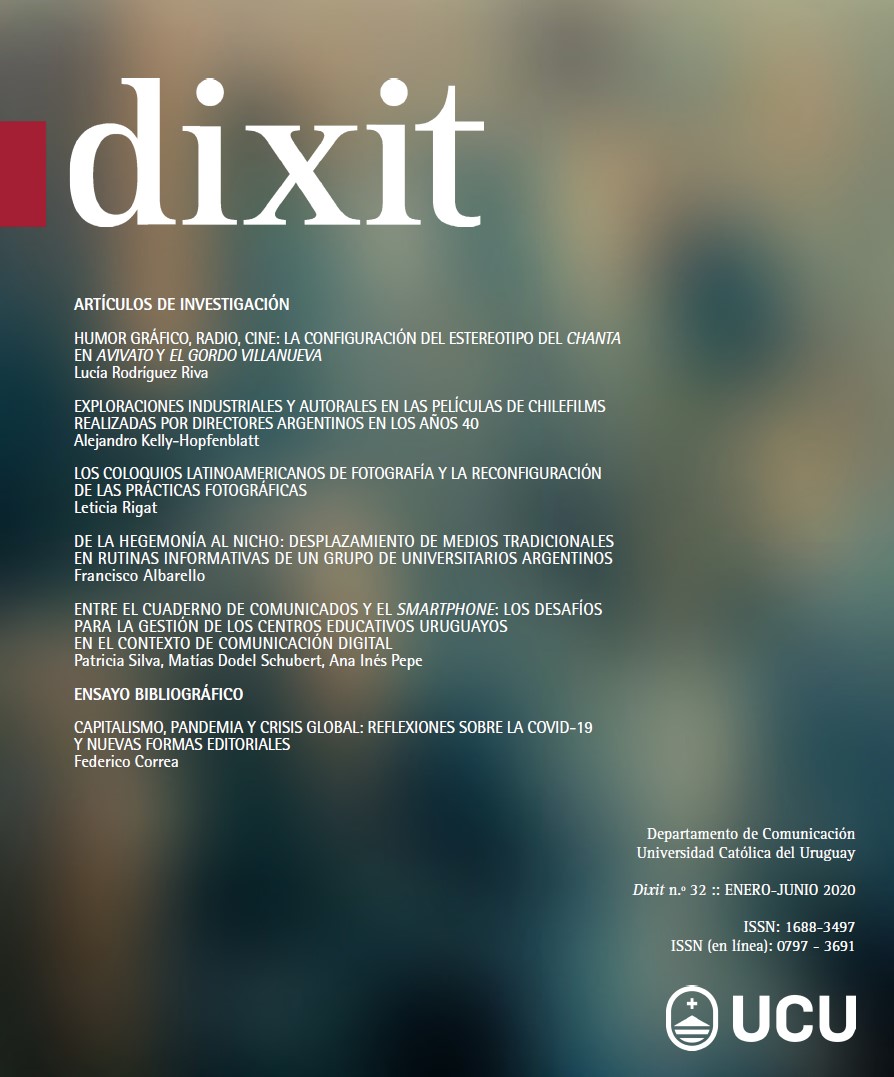Industrial and authorial explorations in Chilefilms movies made by Argentine directors in the 1940s
DOI:
https://doi.org/10.22235/d.vi32.2005Keywords:
classic latin american cinema, film industry, trashumance, modernity, ChilefilmsAbstract
In the decade of 1940 different Latin American countries developed national film industries whose activities implied a constant tension between nationalistic intentions and cosmopolitan productions. Chilefilms is a noteworthy case of study due to its history and some of the movies it produced, mainly two film directed by Argentine filmmakers: La casa está vacía, by Carlos Schlieper, and La dama de la muerte, by Carlos Hugo Christensen. Taking these productions as a starting point, this article looks into historiography’s traditional concepts in order to propose alternative approaches that will enrichen Latin American classical cinema studies. Therefore, their divergences with classical cinema are considered through their time-space construction and their narrative lines, focusing on their detour from generic and authorial traditions.
Downloads
References
Bergfelder, T. (1999). Negotiating Exoticism: Hollywood, Film Europe and the Cultural Reception of Anna May Wong. En A. Highson y R. Maltby (Eds.), “Film Europe” and “Film America”. Cinema, Commerce and Cultural Exchange, 1920-1939 (pp. 302-323). Exeter, Reino Unido: University of Exeter Press.
Bergfelder, T. (2005). International Adventures. German Popular Cinema and European Co-Productions in the 1960s. New York, NY-Oxford, Reino Unido: Berghahn Books.
Bernini, E. (2009). Un cine culto para el pueblo: la transposición como política del cine durante el primer peronismo. Kilómetro 111, 8, 87-101.
Bossay Pisano, C.M. (2008). La época de los grandes ensayos cinematográficos. Estudio de los vínculos entre la industria cinematográfica nacional y el paradigma clásico del cine estadounidense en la década del cuarenta (Tesis de grado). Universidad Diego Portales, Facultad de Ciencias Sociales e Historia, Santiago de Chile.
Hansen, M. (2009). Vernacular Modernism: Tracking Cinema on a Global Scale. En N. Durovicova y K. Newman (Eds.), World Cinemas, Trasnational Perspectives (pp. 287-314). New York, NY: Routledge.
Hayward, S. (2000). Framing National Cinemas. En M. Hjort y S. McKenzie (Eds.), Cinema and Nation (pp. 81-94). London, Reino Unido- New York, NY: Routledge.
Horta Canales, L. (2015). Las alegorías del desdén: revisión histórica de la producción en Chilefilms 1944-1949. En M. P. Peirano y C. Gobantes (Eds.), ChileFilms, el Hollywood criollo. Aproximaciones al proyecto industrial cinematográfico chileno (1942-1949) (pp. 155-192). Santiago, Chile: Cuarto Propio.
Kelly-Hopfenblatt, A. (2019). Modernidad y teléfonos blancos. La comedia burguesa en el cine argentino de los años ’40. Buenos Aires, Argentina: Ciccus.
Kriger, C. (2011), Del periodismo a la historia: Alex Viany y Domingo di Núbila. AdVersuS, 8(21), 85-100.
López, A. (2000). Crossing Nations and Genres. Travelling Filmmakers. En C. Noriega (Ed.), Visible Nations: Latin American Cinema and Video (pp. 67-80). Minneapolis, MN: University of Minnesota Press.
Machuca Serey, A. (2015). Chilefilms, un capítulo ignorado. Imaginario expuesto en las producciones íntegras de la empresa chilena entre 1944 y 1947. En M. P. Peirano y C. Gobantes (Eds.), ChileFilms, el Hollywood criollo. Aproximaciones al proyecto industrial cinematográfico chileno (1942-1949) (pp. 193-246). Santiago, Chile: Cuarto Propio.
Morrow, C. (2012). It’s Good to be the King. Hollywood’s Mythical Monarchies, Troubled Republics, and Crazy Kingdoms. En A. Horton y J. E. Rapf (Eds.), A Companion to Film Comedy (pp. 249-272). Oxford, Reino Unido: Wiley-Blackwell.
Paranaguá, P. A. (2003). Tradición y modernidad en el cine de América Latina. Madrid, España: Fondo de Cultura Económica.
Peirano, M. P. (2015). Chilefilms, el proyecto nacional y los discursos sobre el cine chileno durante la década de 1940. En M. P. Peirano y C. Gobantes (Eds.), ChileFilms, el Hollywood criollo. Aproximaciones al proyecto industrial cinematográfico chileno (1942-1949) (pp. 41-90). Santiago, Chile: Cuarto Propio.
Ruffinelli, J. (1998). Bajo cinco banderas: el cine multinacional de Carlos Hugo Christensen. Nuevo Texto Crítico, 21/22, 277-325.
Schumann, P. (1987). Historia del cine latinoamericano. Buenos Aires, Argentina: Legasa.
Vasey, R. (1997). The World According to Hollywood, 1918-1939. Exeter, Reino Unido: University of Exeter Press.
Filmes
Borcosque, C. (Director). (1945). Amarga verdad [Película]. Chile: Chile Films.
Calderón, G. (Productor) y Portillo, R. (Director). (1957). La momia azteca [Película]. México: Cinematográfica Calderón.
Calderón, J.L. (Productor) y Rivero, F.A. (Director). (1943). Los miserables [Película]. México: Azteca Films.
Christensen, C.H. (Director). (1946). Adán y la serpiente [Película]. Argentina: Lumiton.
Christensen, C.H. (Director). (1946). El ángel desnudo [Película]. Argentina: Lumiton.
Christensen, C.H. (Director). (1946). La dama de la muerte. [Película]. Chile: Chile Films.
de Fuentes, F. (Productor) y Martínez Solares, G. (Director). (1959). La casa del terror [Película]. México: Diana Films.
de Zavalía, A. (Director). (1946). El gran amor de Bécquer [Película]. Argentina: Pyada-Andes.
Edwards, A., Gallart, C. y Warren, J. (Productores) y Warren, J. (Director). (1965). Curse of the Hand Stone [Película]. Estados Unidos: ADP Pictures.
Moglia Barth, L. (Director). (1944). Romance de medio siglo [Película]. Chile: Chile Films.
Ripstein, A. y Santos Galindo, C. (Productores) y Cortés, F. (Director). (1961). La marca del muerto [Película]. México: Alameda Films.
Ripstein, A. y Warren, J. (Productores) y Warren, J. (Director). (1965). Creature of the Walking Dead [Película]. Estados Unidos: Jerry Warren Productions.
Schlieper, C. (Director). (1942). Mañana me suicido [Película]. Argentina: Establecimientos Filmadores Argentinos.
Schlieper, C. (Director). (1944). El deseo [Película]. Argentina: Establecimientos Filmadores Argentinos.
Schlieper, C. (Director). (1945). La casa está vacía [Película]. Chile: Chile Films.
Warren, J. (Productor y Director). (1964). Face of the Screaming Werewolf [Película]. Estados Unidos: Jerry Warren Productions.
Downloads
Published
How to Cite
Issue
Section
License
Copyright (c) 2020 Dixit

This work is licensed under a Creative Commons Attribution 4.0 International License.
From issue number 32 onwards all contents are licensed under the Creative Commons Attribution 4.0 International License (CC BY 4.0).
Issues number 29-31 are licensed under the Creative Commons Attribution-NonCommercial 4.0 International License.
The contents corresponding to number 28 and earlier editions are under the Creative Commons Attribution-NonCommercial-ShareAlike 4.0 International License.


















